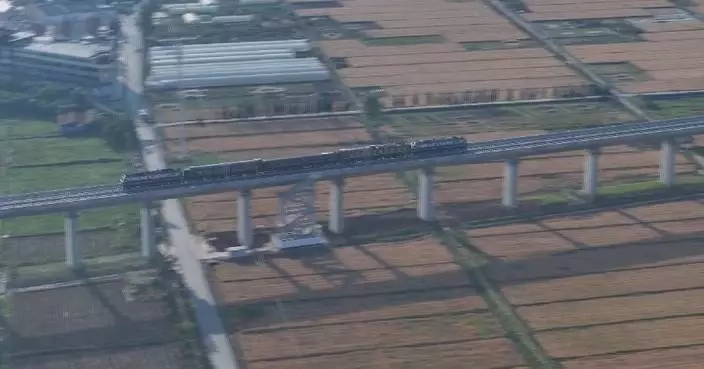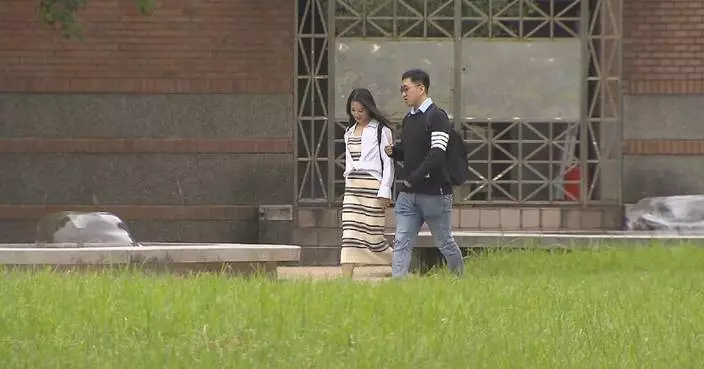Torrential rains on Saturday lashed multiple cities in south China's Guangdong Province including Zhongshan and Zhuhai, with 58 rainstorm alerts in effect across the province.
It is the heaviest rainfall recorded in south China since 1961. Emergency response teams and local authorities have been working to move those at risk to safer areas.
Weather authorities said this round of extreme rainy weather is passing with the advent of sunlight over many areas in Guangzhou, the provincial capital.
From 8:00 to 17:00 Saturday, seven townships and sub-districts in Guangdong recorded precipitation of over 250 mm, and 65 townships and sub-districts recorded 100 mm to 250 mm, according to the Guangdong meteorological observatory.
Floods are in the towns of Sanxiang and Shenwan, essentially turning many of those streets into rivers where many cars are half-submerged.
A township in the city of Zhongshan recorded the highest precipitation of 385.9 mm.
Of the 58 rainstorm alerts in effect by around 15:00 Saturday, five were red alerts and 14 were orange alerts, according to the provincial meteorological authorities.
China has a four-tier, color-coded weather warning system, with red representing the most severe warning, followed by orange, yellow, and blue.
The meteorological authorities in Zhongshan issued a red alert for rainstorms covering the whole city at 16:05 Saturday, with the precipitation in two areas within three hours reaching 100 mm. Local authorities have ordered the temporary closure of parks.
The rains have led to the temporary suspension of some bus services and the closure of some scenic spots in Zhuhai. One meteorological station recorded precipitation of 315.8 mm in six hours to noon. Another meteorological station recorded precipitation of 141 mm within one hour, the largest one-hour rainfall since records began in 1962.
On Saturday afternoon, police authorities in Zhuhai closed part of an expressway as there is a risk of a landslide.
The provincial meteorological authorities ordered precautions against flash floods and geological disasters as further rainstorms are expected in the coming days.

Torrential rains lash multiple cities in south China's Guangdong
Chinese scientists have recently worked together and rebuilt the face of an ancient Chinese ethnic minority emperor via cutting-edge DNA technology.
Emperor Wu of the Xianbei-led Northern Zhou Dynasty (557-581), also known as Yuwen Yong, was an ambitious leader who died at 36. He belonged to the Xianbei nomadic group, which originated from the Mongolian Plateau.
The tomb of the emperor was discovered in 1993 in a village of the city of Xianyang in northwest China's Shaanxi Province. His skull and bones were discovered during an excavation held in 1994 and 1995 at the site of his tomb.
In late March this year, scientists led by the Shaanxi Provincial Institute of Archaeology and the Institute of Archaeological Science of Fudan University managed to decode key features of the emperor and speculate about his cause of death. The emperor might have died from chronic arsenic poisoning due to long-term use of a pellet, which was believed by ancient people to achieve eternal life.
"First, the skeleton can be used to determine age. Second, in terms of age and gender, some pathological research can also be done to see if he had any fractures or other (diseases)," said Zhang Jianlin, a researcher from the Shaanxi Provincial Institute of Archaeology.
Obtaining high-quality genomic data is crucial for restoring the face. Through DNA paleogenomics techniques and optimized DNA extraction, database building and capture methods, more history was revealed.
"First, we have done the shorter fragments enrichment method, which is a DNA extraction method. In addition, we have developed some more sensitive database building method suitable for ancient samples with short fragments. You can regard it as a method to amplify the genetic signal, the extracted DNA. The third is that we have developed a capture method that is more suitable for this kind of highly degraded ancient samples. So we have optimized and improved our approach from three aspects at the same time," said Wen Shaoqing, an associate professor of the Institute of Archaeological Science of Fudan University.
The reconstructed face showed that Yuwen Yong had black hair, yellow skin and brown eyes, while his appearance was typical for people from East or Northeast Asia.
Wen said that with the help of the DNA technology, the accuracy of facial restoration can reach 90 percent.
"As for the accuracy of (facial restoration), the current situation is that if there is a skull as a basis, its accuracy will be relatively high," said Wen.

Scientists rebuild face of ancient emperor using advanced DNA technology










